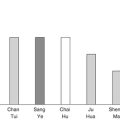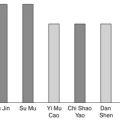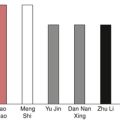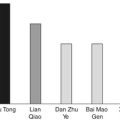Chapter Fourteen. Herbs that tonify
 |
1. What are the functions of tonifying herbs and their indications? What precautions should be observed in their usage?
Tonifying herbs possess tonifying, nourishing, supplementing and strengthening abilities. They are used to treat Deficiency syndromes. As the main substances of the body are the Qi and Essence, which further generate the Blood, Body Fluids, Yin and Yang, the Deficiency syndromes can be generally divided into four types: deficiency of the Qi, deficiency of the Blood, deficiency of the Yin and deficiency of the Yang. They can be further subdivided into the deficiency of specific organs, such as Kidney-Yin deficiency, Spleen-Qi deficiency or Heart-Blood deficiency. Deficiency syndromes may also exist in patients with a weak constitution, in those in the recovery period of diseases, as well as in elderly people and children; in these patients, it is hard to determine which organ is weak and which part should be tonified, as the condition of the patient is generally weak.
The tonifying herbs can be divided into four categories: tonifying the Qi, tonifying the Blood, tonifying the Yin and tonifying the Yang. As the Essence is the basic material of the Qi, Blood, Yin and Yang, tonifying the Essence is included within these four categories. In order for the practitioner to master the functions and applications of tonifying herbs, it is important to compare the characteristics of herbs in different categories as well as those within a single category. Although they all possess tonifying ability, the strength, speed, temperature and nature of each is quite different. For instance, Ren Shen ( Ginseng radix) can tonify the Qi, and its action is quick and strong, therefore it is suitable for treating severe Qi deficiency and is used in the critical condition of Qi collapse. Dang Shen ( Codonopsis radix) and Fu Ling ( Poria) can also tonify the Qi but their action is much gentler and slower than that of Ren Shen. They are especially useful for treating chronic deficiency of the Qi, or conditions in which the patient is unable to bear the strong tonifying herbs. Some herbs such as Shu Di Huang ( Rehmanniae radix praeparata) and Huang Qi ( Astragali radix) are very effective for tonifying Qi deficiency, but their rich and cloying nature places a burden on the Stomach and Spleen; therefore herbs that regulate the Qi to promote digestion should be used in the meantime. In patients who suffer from chronic disease, elderly people or patients with a generally weak constitution, herbs that are neutral and light without a cloying nature should be used—for example, Bai Bian Dou ( Dolichoris lablab semen), Yu Zhu ( Polygonati odorati rhizoma) and Bai He ( Lilii bulbus); they can be used for a longer period of time. There are herbs that tonify certain organs and are particularly suitable for weakness of that organ—for instance, Huang Qi tonifies the Spleen-Qi and Lung-Qi, whereas Bai Zhu ( Atractylodis macrocephalae rhizoma) tonifies only the Spleen-Qi.
The tonifying herbs are used for treating Deficiency syndrome; they are not suitable for use in conditions where substantial excessive pathological products are present, such as Phlegm, food and water accumulation, or stagnation of Qi and Blood. Because of their rich and cloying nature, the tonifying herbs may retain these pathological products in the body. For the same reason, they are not suitable for use in conditions where there are exogenous pathogenic factors. However, in many cases, Deficiency syndromes are complicated with Excess pathological factors, or internal disorders are complicated with external factors, and the factor of Deficiency often plays a causative role in the pathological process, so in these circumstances tonifying herbs can be used in combination with herbs that eliminate Excess pathological factors and exogenous pathogenic factors.
Many tonifying herbs have a sweet and cloying nature, and are therefore not easily digested. As they may cause distension of the abdomen and reduced appetite, they should be combined with herbs that promote Qi movement in the Stomach, Spleen and Large Intestine, especially in patients with deficiency of the Middle Jiao, elderly people and children.
In addition, for treating chronic Deficiency syndromes, the treatment should take place in courses. Generally speaking, winter is a better season to start tonifying treatment than summer because winter is the time of storing and the digestive capability is stronger than in summer. Another way of starting the treatment is following the changes of Yin and Yang in nature: to treat Yin deficiency the treatment should be given in spring and summer; to treat Yang deficiency the treatment should be given in autumn and winter.
2. What are the methods of ‘direct tonifying’ and ‘indirect tonifying’
Direct tonifying and indirect tonifying are commonly used strategies in Chinese herbal medicine. Both are used for treating Deficiency syndromes. ‘Direct tonifying’ means to tonify the weak part of the body directly. For example, Shu Di Huang ( Rehmanniae radix praeparata) can tonify the Kidney-Essence if there is Kidney-Essence deficiency; Huang Qi ( Astragali radix) can tonify the Spleen-Qi and Dang Gui ( Angelicae sinensis radix) can tonify the Liver-Blood directly if there is Spleen-Qi and Liver-Blood deficiency.
‘Indirect tonifying’ means to tonify the body according to the relationship of the Zang Fu organs as well as the relationship of the Qi and Blood. According to the Five Elements theory, the five Zang organs are related by physiology and pathology. By following the cycle of generation, a basic treatment principle for Deficiency syndrome is developed. This principle is: ‘if there is deficiency in one organ, tonify the mother organ’. That is one strategy of indirect tonifying.
Although the five organs can be tonified according to this principle, in clinical practice, some methods are more often used and are more effective than others. For instance, suppose that a patient complains that he often catches cold, his nose is blocked and he also sweats easily. Meanwhile, he has a pale face, his tongue body is pale and flabby with a white coating and his pulse is soft and weak. According to the symptoms and the examinations, the diagnosis is weakness of the Lung-Qi. Therefore, according to this principle, the treatment starts with tonifying the Spleen-Qi, the mother organ of the Lung. When the Spleen-Qi is sufficient, it lifts the Qi to the Lung, thereby strengthening the Exterior. Huang Qi and Bai Zhu ( Atractylodis macrocephalae rhizoma) are often used in this condition. This is called ‘ fertilizing the Earth in order to generate the Metal’. There is another reason why this method is frequently used in clinical practice. It is believed that the Spleen is the source of the Qi and the Lung is the container of the Qi; therefore, to tonify the Lung-Qi, one should start with tonifying the Spleen-Qi. This is why all the herbs that tonify the Lung-Qi and strengthen the Exterior enter both the Lung and Spleen meridians; examples include Huang Qi and Ren Shen ( Ginseng radix). Another commonly used indirect tonifying pattern is called ‘ nourishing the Water to receive the Wood’. It is used in conditions where the Liver-Yin and Blood are so weak that the Liver-Yang escapes the control of the Yin and so it rises up. The treatment method here is to tonify strongly the Kidney-Yin, the mother organ of the Liver, in order to tonify the Liver-Yin and control the Liver-Yang. Because the Kidney and Liver are both located in the Lower Jiao, the Kidney contains the Essence and the Liver contains the Blood; the Kidney-Essence can turn into Blood so as to supplement the Liver-Yin and Blood, and to control the Liver-Yang. This method is very often used for hypertension, glaucoma, menopausal syndrome and diabetes, with symptoms such as headache, dizziness, tinnitus, dry and painful eyes, blurred vision, hot flushes, tingling or numbness of the extremities, a deep red or purple tongue body with or without a thin coating and a thready and wiry pulse. Indirect tonifying can also be used in other conditions—for example, tonifying the Liver-Blood so as to treat Heart-Blood deficiency in the treatment of mental disorders. For instance, one can use Dang Gui, Shu Di Huang, Bai Shao Yao ( Paeoniae radix lactiflora) and Suan Zao Ren ( Ziziphi spinosae semen), which tonify the Blood and enter the Liver meridian, to treat palpitations, restlessness and insomnia.
The indirect tonifying strategy also follows the relationship between Qi and Blood, Yin and Yang of the body or in one organ. According to the concepts that ‘the Qi is the commander of the Blood, the Blood is the mother of the Qi’ and ‘the Yin exists on the Yang and the Yang exists on the Yin’, methods are used to tonify the Qi in order to generate the Blood in the condition of Blood deficiency, and to tonify the Yin in order to generate the Yang in the condition of Yang deficiency. The former is often used in critical situations where the patient has lost a large amount of blood in a short time and it is impossible to supply the blood in a very short period of time. Here Ren Shen and Huang Qi should be used first to strengthen the Qi in order to control and generate the Blood. The latter is often used in situations where the Kidney-Yang is weak—for instance, in elderly people, patients suffering from cold in the back, knees and extremities, clear urine and loose stools. Treatment can be given to tonify the Kidney-Yin strongly, whilst simultaneously using smaller amounts of gentle, sweet and warm herbs to warm the Kidney-Yang, instead of just using hot and pungent herbs to activate the Kidney-Yang, which may consume the Kidney-Yin and, furthermore, also injure the Kidney-Yang.
Comparing the strategy of direct tonifying with that of indirect tonifying, the direct tonifying method can be used alone, whereas the indirect tonifying method is often used with the first method, especially in chronic cases. In the herbal literature, there can be found herbs which have the functions of tonifying both the mother organ and the child organ, the Yin and the Yang, although they have a particular emphasis—for example, Huang Qi primarily tonifies the Spleen-Qi and secondly the Lung-Qi; Dang Gui primarily tonifies the Liver-Blood and secondly the Heart-Blood; Shu Di Huang mainly tonifies the Kidney-Essence and the Kidney-Yin, but gently tonifies Kidney-Yang as well.
3. What is the opinion of the ‘school of tonifying the Spleen’ in the herbal literature?
The concept of the earth being the center can be found in Chinese classics of philosophy and agriculture. In TCM, the idea that the Spleen and Stomach are the principal organs in tonification has a very long history too. In the Jin dynasty, a famous physician Li Dong Yuan wrote a book named Discussion on the Spleen and Stomach ( ad 1249), which completed the theory and treatment based on this concept, and tonifying the Spleen has become a real school of thought since that time.
The ‘school of tonifying the Spleen’ is also called ‘the school of fertilizing the Earth’. People in this school hold the opinion that the Spleen (together with the Stomach) is the foundation of life. After a person is born, the growth and development depend on the condition of the Spleen and Stomach. The Spleen and Stomach are in the Middle Jiao and are responsible for receiving, digesting and transforming food and drink into Essence, Qi, Blood and Body Fluids. Afterwards, the Spleen transports them into the Lung and spreads them throughout the whole body. The unused part of the food and drink is eliminated from the Large Intestine. Although this transportation is partially carried out by the dispersing function of the Lung and the transporting function of the intestines, the Qi of the Lung and intestines also comes from the Spleen.
Furthermore, as the Spleen and Stomach are in the Middle Jiao, which connects the Upper Jiao and Lower Jiao though lifting and descending the water and the Qi, it is a key control system of the body in both physiology and pathology.
Moreover, in practice, tonifying the body through the Spleen is easier and quicker than doing this through other organs. The therapeutic effects show strong support for this school. The Post-Heaven Essence and Qi generated from the Spleen are relatively easier to restore and strengthen compared with the Pre-Heaven Essence and Qi, which are stored in the Kidney. As the Kidney-Essence does not increase much after a person is born, the whole development of the person requires the supplementation of the Spleen-Essence and the Blood. This is a very positive viewpoint in terms of life and health because it implies that one can improve one’s well-being by strengthening the Spleen, no matter how weak a constitution one is born with and how weak the Kidney-Essence and the Kidney-Qi are. Therefore, although the constitution is determined by the Kidney-Essence and Qi, the condition of health can be changed and improved by developing and strengthening the function of the Spleen and Stomach. For instance, one person may be born with a very good constitution, and so has the capability to have a healthy and a long life, but that certainly will not happen if the Kidney-Essence has been consumed quickly and the Spleen is impaired badly by not taking good care of them—for instance, living in a very busy, stressful or unrestrained way for many years, or suffering from fear, anxiety, stress or starvation, such as lived in war or natural disasters. Conversely, a premature baby, although originally having a weaker Pre-Heaven Qi and Essence, may be taken good care of so that the function of the Spleen is supported and developed, and live in a healthy way both physically and mentally, so that overall the person’s health is better, and the life is longer, than in the former case.
For these reasons, the concept and the treatment of protecting and strengthening the Spleen are very widely used in clinical practice. This idea also influences the nursing and dietary ideas and methods of TCM.
4. What is the opinion of the ‘school of tonifying the Kidney’ in the herbal literature?
The ‘school of tonifying the Kidney’ holds the opinion that the Kidney is the most important organ in the body because the Yin, Yang, Qi and Essence of the Kidney are the principal substances of life and the Kidney determines the constitution and vitality of each individual. Moreover, the Yin, Yang, Qi and Essence of the Kidney are the origin of the Yin, Yang, Qi and Essence of the other organs, so the condition of the Kidney determines the condition of the whole body. This school therefore believes that the tonifying process should be started from the Kidney.
From study and practice, this school developed many very effective methods to treat Kidney deficiency based on the understanding of the relationship between Yin, Yang, Qi and Essence of the Kidney. A series of strategies was created. For instance, when treating Kidney-Yin deficiency, the practitioner will add in a small amount of herbs that tonify the Yang to a larger amount of herbs that tonify the Yin; the aim of this is to warm and activate the Yin in order to generate it sufficiently. Conversely, when treating Kidney-Yang deficiency, the practitioner adds some herbs that tonify the Yin with the herbs that tonify the Yang; this is because the Yin is regarded as the root of the Yang. When tonifying either the Yin or the Yang, the practitioner also uses a large amount of herbs that tonify the Kidney-Essence; this is because the Kidney-Essence is the fuel for the Yang and the substantial source of the Yin. When the Kidney-Essence is sufficient, the Yang acts on the Yin, and then generates the Kidney-Qi. This concept can be clearly seen in the formulas Zuo Gui Wan ( Restore the Left Kidney Pill) and You Gui Wan ( Restore the Right Kidney Pill), which were designed by the Taoist physician Zhang Jie Bin in the Ming dynasty.
As the Kidney is regarded as the root of life, this school has also invented many indirect methods of strengthening the other organs through tonifying the Kidney. For instance, when treating Spleen-Yang and Qi deficiency, the practitioner will use herbs that tonify the Kidney-Yang and Qi in order to warm and generate the Spleen-Yang and Qi. When treating a cough, shortness of breath and asthma, which are caused by Lung-Qi deficiency, the practitioner uses herbs that tonify the Kidney in order to grasp the Qi and regulate the breath. To treat chronic cough, thirst, a tendency to be hungry, dry eyes and blurred vision, caused by deficiency of the Lung-Yin, Stomach-Yin and Liver-Yin, the practitioner uses herbs that primarily tonify the Kidney-Yin in order to generate the Yin of these organs. To treat many emotional disorders, such as fear, anxiety or restlessness, or poor memory and inability to concentrate, the method of tonifying the Kidney is also often used.
Since the Kidney-Qi and Kidney-Essence determine the development of the body, the method of tonifying the Kidney plays an important role in the treatment of retardation in children, disorders of menstruation and learning difficulties in young people, infertility, menopausal syndrome in adults and degenerative disease in elderly people.
Since the Kidney-Qi and Kidney-Essence are inherited from the parents and do not increase after birth, some people have a passive attitude about the method of tonifying the Kidney; they think the Kidney-Qi and Kidney-Essence can only be consumed and the constitution cannot be changed as it depends on the Kidney condition. However, the school of tonifying the Kidney believes that, although the Kidney-Essence cannot easily be increased, it can be strong and sufficient if protected and used in the right way. Tonifying the Kidney is impossible to achieve in a short time, but people can use this idea to protect the Kidney in many ways over the whole lifetime. There are many ways to tonify and protect the Kidney, such as Chinese herbal therapy, Qi Gong exercise, Chinese dietary therapy and maintaining a healthy lifestyle. All of these can prevent disease, maintain health and lead to longevity. In this way, a person born with a poor constitution can live a happy and healthy life, and a person born with a robust constitution may live even longer than the average age at that time.
5. What are the differences between strong tonification and gentle tonification?
In strong tonification, either herbs that have a strong tonifying ability, or herbs that are gentle in action but in large dosage, are used to tonify severe weakness of the Qi, Blood, Yin or Yang of the body. This method can be generally divided into strong tonification of the Yang and Qi, and strong tonification of the Yin and Blood. Strong tonification of the Yang and Qi is especially used in critical conditions—for instance, in conditions where there is loss of a large amount of blood in a short time, or in myocardial infarction, when the blood pressure drops or is unstable. Because the substantial parts of the body, such as the Yin, Body Fluids, Blood and Essence, cannot be tonified in a very short time, first the herbs that can strongly and quickly strengthen the Qi and rescue the Yang are used; in order to hold the Blood, the Yin and the Body Fluids, the herbs that tonify the Qi and Yang are administrated immediately by transfusion.
Strong tonification of the Yin and Blood is often used for severe weakness of the Blood and Essence, such as in conditions of advanced wasting in diabetes or starvation, and dyscrasia in advanced cancer. Strong tonification has a particular therapeutic value for treating young patients and patients whose Spleen and Stomach are not impaired as these herbs are rich, sweet and cloying, and they are not easily digested. The commonly used herbs for strong tonification are Ren Shen ( Ginseng radix), Huang Qi ( Astragali radix), Shu Di Huang ( Rehmanniae radix praeparata), Huang Jing ( Polygonati rhizoma) and E Jiao ( Asini corii colla).
In gentle tonification, either herbs that have a gentle tonifying nature, or a small dosage of herbs that have a strong tonifying ability, are used to tonify the Qi, Blood, Yin and Yang gradually in order to treat Deficiency syndromes. This method is used much more often than strong tonification, as the Deficiency syndrome has a chronic process and chronic Deficiency syndromes are seen more often than acute cases in clinical practice.
Also, in chronic cases, all the organs and their functions are impaired, so the body cannot bear the strong tonifying herbs, which are sweet, rich and cloying and often bring about digestive disorders, or are harsh in action and may lead to new disturbances of the Yin and Yang, Qi and Blood. For example, patients who suffer from Qi deficiency will feel dryness in the nose, eyes and throat, and fullness in the chest and Stomach after using a large dosage of Ren Shen or Huang Qi because the herbs are heavy and generate Heat in the body. Patients who suffer from Blood deficiency may have ulcers in the mouth and get heavy menstruation or bleeding after using large amounts of Dang Gui ( Angelicae sinensis radix) or Ren Shen because these herbs are warm and can activate the movement of the weakened Blood and Qi. Patients with dyscrasia can lose their appetite instead of putting on weight because the rich and sweet herbs are too heavy to be digested by a weak Spleen. A gentle method is thus more suitable for different chronic Deficiency syndromes. The commonly used herbs are Dang Shen ( Codonopsis radix), Bai Zhu ( Atractylodis macrocephalae rhizoma), Fu Ling ( Poria), Dang Gui and Bai Shao Yao ( Paeoniae radix lactiflora).
6. What are the indications for herbs that tonify the Qi?
The herbs that tonify the Qi are used for conditions of Qi deficiency. Qi is a type of refined Essence produced by the internal organs. It also promotes the functions of these internal organs. According to its source, the place where it belongs and its function, Qi can be divided into different types, such as Original Qi, Nutritive Qi, Defensive Qi, gathering Qi, Qi of the Zang Fu organs or Qi of the meridians. Qi is able to warm and nourish the body, promote the physiological function of all organs of the body, and protect against the invasion of exogenous pathogenic factors. In a normal condition, Qi circulates smoothly and constantly in the body.
If the Qi is insufficient, it may manifest as either general weakness or specific weakness in a certain organ. The former shows in weakness of the constitution, an inability to endure intensive mental stress and physical exertion, a tendency to tire easily, and to fall ill often and then the disease develops quickly. It is often seen in children, elderly people, patients who are suffering from mild chronic disease or neurosis, and patients recovering from an operation or from disease. Qi deficiency may alternatively manifest in certain organs. For instance, Spleen-Qi deficiency manifests as a poor appetite, abdominal distension, loose stools or diarrhea, a feeling of heaviness in the limbs and fatigue; Lung-Qi deficiency manifests as shortness of breath, a low and weak voice, pallor and a tendency to sweat easily; Heart-Qi deficiency brings about palpitations, restlessness, tightness in the chest, perspiration, and a faint and irregular pulse; Kidney-Qi deficiency may cause retardation of development, a poor constitution, spermatorrhea, premature ejaculation, edema, enuresis, urinary incontinence, and weakness in the back and legs. In Qi deficiency conditions, the tongue is pale or slightly pale, the body of the tongue is flabby, with teeth marks in a severe case, and the coating is white, or white and sticky. The pulse is weak and soft, or deep and thready, especially at the region of the corresponding organ.
The herbs that tonify the Qi are very effective for improving the general condition and treating general weakness of the Qi. They can also tonify the Qi of a specific organ as the herbs enter different meridians and have specific functions for that organ. However, there are some exceptions. For instance, herbs that tonify the Kidney-Qi are just the herbs that tonify the Kidney-Essence, Yin and Yang because the Kidney-Qi is developed directly from these. Another example is the tonification of the Liver-Qi; since the Liver-Qi is directly generated by the Liver-Blood, the herbs that treat Liver-Qi deficiency are just the herbs that treat Liver-Blood deficiency.
7. What are the characteristics of the herbs that tonify the Qi?
The herbs that are able to tonify the Qi of the body have the following characteristic properties.
Sweet in taste
Most of herbs that tonify the Qi have a sweet taste. Sweetness has a nourishing, moistening and harmonizing nature, so is able to tonify the Qi, especially the substantial aspect of the Qi, in order to treat disorders caused by Qi deficiency. The therapeutic result of tonifying by sweet herbs is achieved from three approaches. First of all, sweetness is a suitable taste for Qi deficiency as, in the case of Qi deficiency, both the Qi and Yang are impaired. The syndrome shows as general weakness and coldness. If warm and pungent herbs are used to warm and activate the Qi and Yang, the condition of the patient can be improved in a short period of time. After a while, however, the symptoms reappear. Meanwhile, patients may complain of dryness in the nose, throat and mouth, constipation and even bleeding. This is because warmth and pungency can activate the function of the body, but do not tonify the substantial parts of it. Without supplementation of the substantial parts, such as the Yin, Body Fluids and Essence, the functional improvement does not last long. Warmth and pungency may consume the Yin and the Blood of the body, and bring about a side-effect of Dryness. In contrast, sweet herbs are neutral with respect to the Yin, Yang, Qi and Blood; they can tonify one party without injuring the others. Thus they are able not only to tonify the Qi, but also to nourish the Blood and Yin as well. As they do not give rise to a side-effect of Dryness, they are suitable for Qi deficiency and disharmony of the Qi and Blood, Yin and Yang. Secondly, sweetness enters the Spleen, the most important organ for Qi generation. The Spleen is located in the Middle Jiao, and connects with the Upper Jiao and Lower Jiao, so is very important for Qi transportation. Sweetness especially benefits the Spleen-Qi and strengthens its function, therefore spreading the Qi within the entire body. Thirdly, because sweetness remains working in one place and has no moving tendency, it may reduce the speed of an aggressive pathogenic process, moderate the harsh properties of herbs in a tonifying formula and slow the haste of other herbs so as to prevent the side-effects of these herbs.
Slightly warm in temperature
Most of the herbs that tonify the Qi are slightly warm in temperature. As Qi must constantly move, it needs not only the substantial part, which can be obtained from the sweet taste of the herbs, but also a moving capability, which can be increased by the warm nature of the herbs. When gentle warmth and sweetness coexist in one herb, the tonifying action shows clearly. This action is described as: ‘t he gentle Fire steams the sweet, and then the Qi is generated gradually’. However, the herbs should be warm rather than hot because hot herbs consume the Yin and Qi. So there is also a saying: ‘t he gentle Fire generates the Qi and the strong Fire destroys the Qi’.
Entering the Spleen and Lung meridians
Most of the herbs that tonify the Qi mainly enter the Spleen and Lung meridians. As the Spleen is the most important organ for producing the Qi, the herbs that enter the Spleen may effectively tonify the Qi of the whole body. Since the Lung can disperse and descend the Qi, it is an important organ for transporting and regulating the Qi. The herbs that enter the Lung meridian are effective for strengthening the function of the Lung and accelerating the Qi movement.
Bitter in taste
Some of the herbs that tonify the Qi have a bitter taste, which possesses a drying ability. When the Qi is deficient in the body, and especially when the Spleen-Qi is deficient, the Qi may fail to transport Dampness and cause water or Dampness accumulation. Herbs that have bitter or bitter-warm properties may dry Dampness and strengthen the function of the Spleen as well as the other internal organs so as to treat Qi deficiency. Bai Zhu ( Atractylodis macrocephalae rhizoma) is a good example.
Bland and neutral
Some of the herbs that tonify the Qi are bland and neutral. Blandness is able to leach out Dampness and promote urination. It is suitable for treating accumulation of Dampness that is caused by the Qi deficiency. Neutrality is an ideal temperature to treat disorders where Heat and Cold are complicated. Neutrality is easily combined with other tastes and temperature to treat Qi deficiency with the disharmony of the Blood, Yin and Yang. The commonly used herb is Fu Ling ( Poria).
In addition, herbs that tonify the Qi may have some side-effects. These are mainly caused by their rich nature and the sweet taste, which place an extra burden on the Spleen and lead to Qi stagnation and Dampness accumulation. The manifestations of this are fullness of the epigastrium, distension of the abdomen and difficulty of bowel movement. To avoid this, in clinical practice, these tonifying herbs are often used with a small amount of herbs that promote Qi movement, such as Chen Pi ( Citri reticulatae pericarpium) and Mu Xiang ( Aucklandiae radix)**.
8. Ren Shen ( Ginseng radix) and Huang Qi ( Astragali radix) are the most important herbs for tonifying the Qi. What are their characteristics?
Ren Shen and Huang Qi are two strong herbs for tonifying the Qi. Both are sweet and slightly warm, and enter the Spleen and Lung meridians. Sweetness possesses a tonifying ability and the gentle warmth may gently strengthen the Yang, which further generates the Qi. They strongly tonify the Spleen-Qi, strengthen the Middle Jiao and promote the function of the Spleen to generate the Blood, Essence and Body Fluids. They can treat Spleen-Qi deficiency, which manifests as poor appetite, distension of the abdomen, loose stools, diarrhea and fatigue.
The Spleen, together with the Stomach, is regarded as the foundation of the life after birth. When the Spleen-Qi is strong enough, it can transport the Qi to the Lung so as to strengthen the Lung-Qi and the Defensive Qi. Both herbs are very effective for treating Lung-Qi deficiency, which manifests as shortness of breath, a weak voice, a tendency to catch cold and spontaneous sweating.
Ren Shen is particularly able to tonify the Original Qi and rescue the Yang and so is used for critical conditions where the Qi is severely injured and the Yang has collapsed. The patient may have shallow respiration, cold limbs, a pale face, profuse sweating and a very weak pulse. These conditions can be seen after severe vomiting or diarrhea, shock, fainting or losing a large amount of Blood. Because Ren Shen can strongly tonify the Original Qi, the principal Qi of the body, it can also tonify the Qi of all the internal organs—for instance, it tonifies the Heart-Qi, calms the Mind and therefore treats palpitations and restlessness. It can tonify the Spleen-Qi and promote the function of the Spleen. Moreover, it promotes the generation of the Blood and treats fatigue, insomnia and dizziness caused by Qi and Blood deficiency. It also promotes the generation of the Body Fluids and therefore treats profuse sweating and thirst caused by Qi and Yin deficiency.
Huang Qi is warmer than Ren Shen in temperature. As it does not tonify the Original Qi, it is not used in critical conditions or in Qi deficiency of all the internal organs. Huang Qi enters the Spleen and Lung meridians and its function focuses on the Spleen and the Lung. It can strongly tonify the Spleen-Qi and promote its function, strengthening the foundation of life so as to improve the patient’s condition and strengthen the Qi in general. It is able to lift the Spleen-Qi and increase the strength of the muscles, which are controlled by the Spleen, and so it treats a prolapsed uterus, Stomach and rectum, as well as tiredness and heavy sensations in the body and limbs. Because it can tonify the Spleen-Qi and strengthen the muscles, it can promote the healing process in chronic ulceration, sores or wounding. It also strengthens the Spleen-Qi and controls the Blood, which must circulate in the blood vessels, and therefore can be used in bleeding conditions.
Huang Qi has another very important function—to tonify the Lung-Qi and stabilize the Exterior. Huang Qi can strongly tonify the Spleen-Qi, which can then further transport the Qi to the Lung; therefore it treats shortness of breath, and a low and weak voice, caused by the Lung-Qi deficiency. Furthermore, when the Spleen-Qi and the Lung-Qi are sufficient, the Defensive Qi is also strong; thus it can control the pores better and promote the Qi and Blood circulation on the surface of the body so as to strengthen the Exterior. This is why Huang Qi is often used to treat recurrent colds, spontaneous sweating and chronic sinusitis.
Ren Shen and Huang Qi have their own characteristic actions in tonifying the Qi. They are also characterized by their quick actions. In clinical practice, they can be used together to treat severe Qi deficiency. However, they can bring about some side-effects because of their rich and warm nature, especially in patients with deficiency of the Spleen and Stomach. If the patient complains of fullness in the Stomach or distension in the abdomen, herbs that promote the digestion should be used, such as Chen Pi ( Citri reticulatae pericarpium) and Sha Ren ( Amomi xanthioidis fructus).
9. What are the differences between the different products of Ren Shen ( Ginseng radix)?
Ren Shen and its products are classified into many types according to the habitat, climate, the conditions of cultivation and the processing procedure. The properties and the functions of Ren Shen therefore vary vastly.
The type called ‘Ye Shan Shen’, or the ‘wild mountain root’, grows in the Chang Bai Mountain between China and Korea, and is regarded as the best quality of Ren Shen. Its function of tonifying the Qi is the strongest. Since the herb grows in the mountains for many years and is not easy to find, the price is very high and it is used only for very severe cases.
Most of the Ren Shen used today is cultivated. Its effect in tonifying the Qi is not as strong as that of the wild root. After it is collected, washed and then dried by wind or the sun, the product is called ‘Sheng Shai Shen’, or ‘raw dried root’. It is sweet and neutral, and is effective for tonifying the Qi as well as nourishing the Yin. Its function is relatively strong for cultivated Ren Shen.
Alternatively, after the fresh Ren Shen is collected, washed and peeled, it may be steamed for 2–3 hours, and then dried. The color then becomes dark red or brown, and this product is called ‘Hong Shen’, or ‘red root’. Its strength in the action of tonifying the Qi is similar to that of Sheng Shai Shen, but it is warm and sweet, so is often used for Qi and Yang deficiency. It is also used in winter for patients with Qi deficiency and elderly people.
If fresh Ren Shen is cured in rock candy, it is called ‘Bai Shen’, or ‘white root’. This has a gentler action of tonifying the Qi compared with the other products.
‘Xi Yang Shen’ ( Panacis quinquefolii radix), also called ‘Hua Qi Shen’, is sweet and cold in nature, and its function in tonifying the Qi is as strong as that of Sheng Shai Shen, but its action in nourishing the Yin is stronger than that of Sheng Shai Shen. As it can also clear Heat in the body, it is often used for the syndrome of deficiency of Qi and Yin with Empty-Fire, such as seen in diabetes and pulmonary tuberculosis.
Habitat is also important in the quality of Ren Shen. For instance, a product called ‘Ji Lin Shen’, because it is from Ji Lin province, which is located in the Chang Bai Mountain, is of good quality. Korean Ren Shen, which is also called ‘Gao Li Shen’, is warm and sweet, has a similar function to Hong Shen but is stronger for warming the Interior and tonifying the Qi. Although all the products of Ren Shen can tonify the Qi, from a clinical viewpoint it is necessary to make the proper choice from the different products to achieve the best effect.
10. Xi Yang Shen ( Panacis quinquefolii radix), Sheng Shai Shen (raw dried Ginseng radix), Tai Zi Shen ( Pseudostellariae radix) and Bei Sha Shen ( Glehniae radix) are all able to tonify the Qi and Yin. What are the differences between their actions?
The syndrome of Qi and Yin deficiency can develop from different diseases. One of them is febrile disease, such as pneumonia, pulmonary tuberculosis and viral myocarditis. The Qi and Yin are consumed by Heat in the pathological process. The syndrome can also develop from chronic disease due to weakness and disharmony of the Yin, Yang, Qi and Blood. For instance, in Waste and Thirsty syndrome (diabetes), the Yin of the Lung, Heart, Stomach, Liver and Kidney are all impaired. The symptoms of Qi and Yin deficiency are shortness of breath, tiredness, spontaneous sweating, thirst, palpitations, restlessness, insomnia, a reduced appetite, preference for drinking rather than eating, or getting hungry easily but not being willing to eat, dizziness, weakness in the back and spermatorrhea.
These four herbs are all able to tonify the Qi and Yin. They can be used for Qi and Yin deficiency of the Lung, Heart, Stomach and Kidney, but there are differences between their actions.
Xi Yang Shen is sweet, bitter and cold, and enters the Heart, Lung and Kidney meridians. It can tonify the Qi and generate Yin, and is the strongest among these four herbs. Since it is bitter and cold, it is able to clear Heat and reduce Fire, and is suitable for treating Qi and Yin deficiency with Excessive- or Empty-Fire. It can treat afternoon fever, irritability, warm palms, thirst, fatigue, hemoptysis, a shortened menstrual cycle or heavy menstruation.
Sheng Shai Shen, the raw, dried, and cultivated Ren Shen, is sweet and neutral. Its function is similar to that of Xi Yang Shen. To tonify the Qi and the Yin, it is as strong as Xi Yang Shen. However, this herb is not so cold and not bitter; therefore it cannot clear Heat and reduce Fire. If there is Heat in the syndrome, Xi Yang Shen is a better choice than Sheng Shai Shen.
Tai Zi Shen is slightly cold and bitter, and it enters the Spleen and Lung meridians. It can tonify the Qi and Yin of the Spleen and Lung but the function is weaker than that of Xi Yang Shen and Sheng Shai Shen. It must be used for a long period of time and in large dosage to treat Deficiency syndromes. However, its gentle and moderate nature is particularly suitable for patients with a rather weak constitution or only slight Yin deficiency. It is also used in patients who are in the recovery period of febrile diseases, in those who have a poor appetite, and are tired and thirsty, and for patients suffering from chronic diseases who cannot bear the strong tonifying herbs.
Bei Sha Shen is sweet and cold, and enters the Lung and Stomach meridians. The main function of the herb is to nourish the Yin and generate the Body Fluids. It has the function of tonifying the Qi but is very weak compared with the other three herbs. In clinical practice, if there is slight Qi deficiency in a Yin deficiency syndrome, this herb is a good choice.
11. What are the differences between Ren Shen ( Ginseng radix) and Dang Shen ( Codonopsis radix)?
Ren Shen is the most important herb for tonifying the Qi. It can tonify the Original Qi, therefore it is able to rescue collapsed Yang. It can also strongly tonify the Spleen-Qi, which is considered as the foundation of life and the source of Qi and Blood. However, although Ren Shen is an excellent herb for tonifying the Qi and promoting the functions of all the internal organs, it is very expensive if good quality products are required, therefore it is only used in severe cases. In most cases of Qi deficiency, and especially in chronic disorders, a large dosage of Dang Shen is often used as an effective substitution for Ren Shen.
Dang Shen is sweet and neutral, and enters the Spleen and Lung meridians. However, since it does not enter the Kidney meridian, it has no function in tonifying the Original Qi and so cannot be used in critical conditions. In acute Yang collapse condition, therefore, Ren Shen must be used. However, Dang Shen is effective for tonifying the Spleen-Qi and the Lung-Qi, and its action is much gentler than that of Ren Shen. The strong point of this herb is that it is not heavy and sticky, and does not generate Heat and Dryness in the body, so is more suitable for many chronic diseases with Spleen-Qi and Lung-Qi deficiency. It can also generate the Yin and Body Fluids, so is also used for deficiency of both Qi and Yin. In addition, a large dosage of Dang Shen (i.e. at least six times the dosage of Ren Shen) can be used as a substitute for Ren Shen in treating severe deficiency of the Spleen-Qi and Lung-Qi.
12. What are the differences in actions and applications between Huang Qi ( Astragali radix) and Bai Zhu ( Atractylodis macrocephalae rhizoma)?
Huang Qi and Bai Zhu are both commonly used for tonifying Qi and are also often used together. Both are sweet and warm, and enter the Spleen meridian. Both can strengthen the Middle Jiao and tonify the Spleen-Qi, therefore treating Spleen-Qi deficiency. They are also used together to strengthen the transportation function of the Spleen, eliminate Dampness and treat edema. Although the applications are similar, there are differences between their properties and actions.
Huang Qi is sweeter and warmer than Bai Zhu, and its action in tonifying the Spleen-Qi is stronger. Its specific action is to tonify the Qi, raise the Yang-Qi of the Spleen and increase the strength of muscles. It not only treats a poor appetite and indigestion, but also chronic diarrhea and prolapsed rectum, stomach, uterus or other internal organs. Furthermore, Huang Qi strengthens not only the muscles of the internal organs, but also those in the whole body, so it can be used for patients who complain of weakness and heaviness in the limbs and tiredness, such as seen in chronic fatigue syndrome. Moreover, since Huang Qi can improve the condition of the muscles, it is also able to promote the healing of wounds after operations or trauma.
As the Spleen controls the Blood circulating in the blood vessels, the ascending and tonifying function of Huang Qi can control the Blood; therefore this herb can be used in bleeding conditions caused by Spleen-Qi deficiency, such as seen in uterine bleeding, blood in the stools and purpura. It is also able to tonify the Spleen-Qi and transport the Dampness in time, so it can treat edema.
Bai Zhu is also sweet and warm, and can tonify the Spleen-Qi like Huang Qi; however, it is bitter in taste. Its effect in tonifying the Spleen-Qi is weaker than that of Huang Qi, and it has no function in raising the Spleen-Qi and controlling the Blood. However, its bitter and warm property can dry Dampness; therefore its characteristics are tonifying of the Spleen-Qi and transformation of Dampness. It can treat poor appetite, fullness in the Stomach, distension in the abdomen, diarrhea and heaviness of the limbs.
There are also some other differences between the two herbs. Huang Qi, and especially raw Huang Qi, enters the Lung meridian and can strengthen the Lung-Qi and the Defensive Qi. It is especially suitable for treating a deficiency of both the Spleen-Qi and Lung-Qi. In this condition the patient has a poor appetite, distension in the abdomen and loose stools, as well as spontaneous sweating, recurrent colds, shortness of breath and tiredness. Huang Qi can strengthen the Lung-Qi so as to regulate the water metabolism and treat edema, especially edema on the face and upper part of the body.
Bai Zhu does not enter the Lung meridian, and has little influence on the Lung-Qi and the Defensive Qi. However, it enters the Stomach meridian and can promote digestion and treat lack of appetite and fullness in the Stomach. It is often used for malnutrition in children. Furthermore, since it can regulate the whole function of the Middle Jiao, and it has no tendency to move upwards or downwards, it is often used to calm a restless fetus caused by Spleen-Qi deficiency in pregnant women.
As sinking of Spleen-Qi, weakness of the muscles and accumulation of Dampness often exist at the same time when the Spleen-Qi is weak, Huang Qi and Bai Zhu are often used together to treat those disorders.
13. What are the differences between raw Bai Zhu ( Atractylodis macrocephalae rhizoma), Chao Bai Zhu (dry-fried Atractylodis macrocephalae rhizoma) and Jiao Bai Zhu (deep-dry-fried Atractylodis macrocephalae rhizoma)?
Bai Zhu, the very commonly used herb for tonifying the Spleen-Qi, can be processed in several ways to meet different clinical needs.
Raw Bai Zhu is the strongest of the products to tonify the Spleen-Qi, and it treats reduced appetite, indigestion, tiredness and a wan complexion.
When Bai Zhu is dry-fried, its action in drying Dampness is increased. It is especially effective for treating distension in the abdomen, loose stools and diarrhea.
When the color of the herb turns to deep brown after dry frying, it is then called ‘Jiao Bai Zhu’. This enters the Stomach meridian particularly and has the strongest effect in strengthening the receiving, ripening and transporting functions of the Stomach of the Bai Zhu products. It is very useful for treating a poor appetite, nausea, fullness in the Stomach and belching.
14. What are the differences in the functions of tonifying the Spleen-Qi and eliminating Dampness between Bai Zhu ( Atractylodis macrocephalae rhizoma) and Fu Ling ( Poria)?
Bai Zhu and Fu Ling both can tonify the Spleen-Qi and eliminate Dampness from the Middle Jiao. In clinical practice, they are often used together. However, there are differences between these two herbs.
Bai Zhu is warm and bitter, and its action in tonifying the Spleen-Qi is stronger than that of Fu Ling. At the same time, it can also strengthen the Stomach.
Fu Ling is neutral and bland, and it can gently tonify the Qi. It can be used with either warm or cold herbs to warm the Spleen-Yang, tonify the Spleen-Qi or eliminate Damp-Heat in the Middle Jiao. Fu Ling also has another function: it can tonify the Heart-Qi and therefore is used for calming the Mind. Because the function of Fu Ling is gentle and it has no strong taste, it can be used for a long period of time in chronic and mild syndromes of Qi deficiency of the Spleen and Heart. It is also used in Chinese food and biscuits as a health food supplement.
Both herbs can eliminate Dampness in the Middle Jiao, but they treat the same pathogenic factor by different approaches. Bai Zhu dries the Dampness in the Middle Jiao, as it is bitter and warm; Fu Ling promotes urination and leaches out Dampness from the Lower Jiao. Also, Bai Zhu can tonify the Spleen and calm the fetus, whereas Fu Ling is forbidden for use in pregnant women as its action has a descending tendency.
15. Bai Zhu ( Atractylodis macrocephalae rhizoma), Shan Yao ( Dioscoreae rhizoma) and Bai Bian Dou ( Dolichoris lablab semen) are able to tonify the Spleen-Qi and stop diarrhea. What are the differences between their actions?
Bai Zhu, Shan Yao and Bai Bian Dou all enter the Spleen meridian. They have the function of tonifying the Spleen-Qi and are used for treating weakness of the Spleen-Qi and dysfunction of transportation and transformation of food and water in the Middle Jiao. They can also reduce accumulation of Dampness and stop diarrhea. However, these three herbs have their own characteristic properties and actions.
Bai Zhu is bitter and warm, and is an important herb for tonifying the Spleen-Qi and strengthening the function of the Spleen and Stomach. As Dampness easily accumulates when the Spleen-Qi is weak, this herb is particularly suitable for this situation as it is bitter and warm in nature and can dry the Dampness, therefore treating diarrhea as well as edema.
Shan Yao is neutral and sweet. Although its effect in tonifying the Spleen-Qi is not as strong as that of Bai Zhu, it can tonify either the Qi or the Yin, so it is especially suitable for treating deficiency of both Qi and Yin in the Middle Jiao. It also has a slightly astringent property, which is helpful for stopping diarrhea. Furthermore, this herb also enters the Lung and Kidney meridians, so is effective for tonifying and stabilizing the Qi and Yin of these organs. It can be used for patients suffering from a lack of appetite, fatigue, loose stools, shortness of breath, thirst and sweating.
Bai Bian Dao is sweet and slightly warm. Its action in tonifying the Spleen-Qi is the weakest of the three herbs, but it is neither dry nor moist, and is neutral and gentle. Unlike Bai Zhu, it can tonify the Spleen without the possibility of consuming the Yin and Body Fluids in the Middle Jiao; it is also unlike Shan Yao in that it can tonify the Spleen without the possibility of leaving Dampness in the Middle Jiao. It is especially suitable for treating chronic mild Qi deficiency of the Spleen and for use in the recovery period after a chronic disease when the condition of the patient is too weak to accept strong tonification.
These three herbs all stop diarrhea through different approaches. Bai Zhu dries Dampness in the Middle Jiao to stop diarrhea; Shan Yao stabilizes the Qi and Yin so as to stop diarrhea; Bai Bian Dou has both of these functions but is weaker in its action. It can also reduce Summer-Heat and treat diarrhea, vomiting and abdominal pain in influenza, acute gastroenteritis and heatstroke.
In clinical practice, Bai Zhu and Shan Yao are often used together to treat Qi deficiency of the Spleen and stop diarrhea, but Shan Yao should not be used if there is accumulation of Dampness in the Middle Jiao and the patient complains of distension in the abdomen. Bai Zhu should not be used if there is deficiency of the Yin or Body Fluids. Bai Bian Dou is used only for mild cases, or is administrated together with other herbs.
16. What are the characteristics of Gan Cao ( Glycyrrhizae radix)?
Compared with other tonifying herbs, such as Huang Qi ( Astragali radix) and Bai Zhu ( Atractylodis macrocephalae rhizoma), the tonifying function of Gan Cao is weak. However, this herb has been studied and used to tonify the Qi since ancient times. In the book Discussion on the Febrile Diseases by Zhang Zhong Jing written 2000 years ago, Gan Cao is the most commonly used herb for tonifying the Qi and moistening Dryness, as well as for harmonizing the Yin and Yang. It was even used in critical conditions of collapse of Qi and Yang. Nowadays, although Gan Cao is not the first-line choice for treating Qi deficiency, it is still often used in combination with other tonifying herbs.
Gan Cao enters all the meridians, and is sweet and neutral in nature. According to the concept that the combination of sweetness, warmth and pungency in herbs gives an ability to tonify the Yang, and the combination of sweetness, cold and sourness in herbs gives an ability to nourish the Yin, Gan Cao is often used in combination with cold or warm herbs in order to tonify the Yin or the Yang respectively.
The moderate tonifying action is the most important characteristic of this herb. As sweetness may slow speed, release tension and alleviate the conflict of two or more parties in a pathological development, this herb can be used in critical conditions, such as Qi, Blood, Yin and Yang collapse.
The moderate nature of Gan Cao is also used in certain specific situations. For instance, it is very effective for treating cramp in the muscles caused by the Liver-Qi overcontrolling the Spleen. A large dosage of Gan Cao is excellent for tonifying the Qi and harmonizing its Qi movement. It can also treat Heart-Qi deficiency, which leads to a failure to promote the Blood circulation, and manifests as restlessness and palpitations, tightness in the chest and arrhythmia.
The moderate nature of Gan Cao is often useful in herbal combinations as well. In most formulas, Gan Cao plays the role of reducing the side-effects of harsh herbs, harmonizing herbs that move in different directions and work on different levels, and moderating quick actions of herbs to a steady and constant action.
There are differences between raw Gan Cao and toasted Gan Cao. The raw form is sweet and neutral and, besides the functions mentioned before, it is able to clear Heat and relieve toxicity. The toasted form is sweeter and slightly warm, it especially enters the Middle Jiao, and its function of tonifying and harmonizing the Qi is stronger than that of the raw form.
Although Gan Cao is often used in many formulas, its sweet property lacks a moving potential, and its use may lead to stagnation of Qi, retain Dampness and cause distension of the Stomach and abdomen. Therefore, patients with Dampness in the Middle Jiao should not use this herb in a large dosage. In addition, sweetness may worsen vomiting, and so patients with rebellious Stomach-Qi should not use this herb either.
17. What are the indications for the herbs that tonify the Blood?
Herbs that tonify the Blood are used for Blood deficiency. Blood is one of the principal substances of the body, and it is a type of refined Essence produced by the internal organs. It circulates smoothly and constantly in the body, nourishes and supports the internal organs, and maintains the functions and structures of the body. If the Blood is not sufficient, there are symptoms such as dry eyes, blurred vision, stiffness of the muscles and joints, tingling or numbness in the muscles, dryness and itching of the skin, irregular menstruation and tiredness.
The mental state and activities of people are also dependent on sufficient Blood; if it is deficient, the patient may suffer from palpitations, restlessness, poor memory, inability to concentrate, insomnia and dream-disturbed sleep. Most patients with Blood deficiency have a pale or pallid complexion, a cracked, pale or delicate pink tongue and a thready and wiry, or thready and weak pulse.
The herbs that tonify the Blood can treat the Kidney-Essence deficiency as well. Because the Blood and Essence are the substantial parts of the body and can turn into each other in the body, herbs that tonify the Blood are often used for treating infertility, poor memory, blurred vision, deafness and retarded development in children.
In clinical practice, the syndrome of Blood deficiency is often caused by Blood loss, weak constitution and chronic disease, and can be seen in various anemias, menstrual disorders, malnutrition, hypotension, after an operation or after giving birth.
18. What are the characteristics of the herbs that tonify the Blood?
The herbs that tonify the Blood have the following characteristics.
Sweet and slightly warm
Since sweetness has a nourishing, moistening and harmonizing nature, and warmth (especially slight warmth) may activate and promote the functions of the internal organs, sweet-warm herbs can generate the Blood and tonify the Essence. They are especially suitable for treating patients who have not only Blood deficiency but also a mild Yang and Qi deficiency of the body. The commonly used herbs are Shu Di Huang ( Rehmanniae radix praeparata), He Shou Wu ( Polygoni multiflori radix), Dang Gui ( Angelicae sinensis radix), Long Yan Rou ( Longanae arillus) and Da Zao ( Jujubae fructus).
Sweet and cold
Because sweetness can tonify the body, especially the substantial aspect of the body, and Cold can clear Heat, sweet-cold herbs can generate the Yin, Body Fluids and Blood. They are especially suitable for treating patients who have not only Blood deficiency but also a mild Yin deficiency with slight Empty-Heat in the Blood. The commonly used herbs are Bai Shao Yao ( Paeoniae radix lactiflora) and Sang Shen ( Mori fructus).
Entering the Heart, Liver, Kidney and Spleen meridians
Because the Heart governs the Blood and promotes the Blood circulation, the Liver stores and regulates the amount of Blood in circulation, the Kidney-Essence can turn into Blood and the Spleen can produce Blood from the Food-Essence, most of the herbs that tonify the Blood enter these meridians. For instance, Dang Gui ( Angelicae sinensis radix) mainly enters the Heart and the Liver meridians, Gou Qi Zi ( Lycii fructus) and Sang Shen enter the Liver and Kidney meridians and Long Yan Rou enters the Spleen meridian.
Tonifying the Blood and the Kidney-Essence
Many of the herbs that enter the Kidney and Liver meridians are able to tonify the Blood as well as the Kidney-Essence. Because the Blood and Essence both belong to the Yin, they are the substantial part of the body, and have a nourishing function. The Blood and Essence can turn into each other in the body. The herbs that can tonify both Blood and the Kidney-Essence are Shu Di Huang, Gou Qi Zi, He Shou Wu and Sang Shen.
19. What precautions should be observed when the herbs that tonify the Blood are used?
Most of the patients who suffer from the syndrome of Blood deficiency also have a slight deficiency of Yin or Yang according to the constitution and the duration of the disease. If there is Yin deficiency, the patient may feel warmth in the chest, thirst or dryness in the mouth and also suffer from constipation and restlessness. A thin tongue body with fresh red or pink color without a coating and a restless and thready pulse are often present too. Herbs that are sweet and cold in nature should be used in this condition. If there is mild Yang deficiency, the patient is fearful of cold, has cold hands and feet, and feels tired. A dull pale tongue proper with a white coating and a deep, thready and slow pulse are often present. Herbs that are sweet and warm in nature should be used at this time.
Because of the relationship between the Qi and Blood, it is wise to choose a small amount of herbs that tonify the Qi in order to enhance the therapeutic result of tonifying the Blood, such as Huang Qi ( Astragali radix) and Da Zao ( Jujubae fructus).
Most of the herbs that tonify the Blood are rich and cloying in nature, so may place an extra burden on the Spleen and Stomach and cause a reduced appetite, distension in the abdomen and difficult bowel movement, especially in patients who suffer from digestive disorders; therefore herbs that regulate the Qi in the Middle Jiao should be used at the same time, such as Chen Pi ( Citri reticulatae pericarpium), Ban Xia ( Pinelliae rhizoma), Mu Xiang ( Aucklandiae radix)** and Sha Ren ( Amomi xanthioidis fructus).
20. What are the differences between Shu Di Huang ( Rehmanniae radix praeparata) and He Shou Wu ( Polygoni multiflori radix) in nourishing the Blood?
Both of these herbs enter the Kidney meridian, and are sweet and slightly warm in nature. They are able to tonify the Kidney-Essence and nourish the Blood. They treat weakness and stiffness in the back and knees, blurred vision, poor memory, disorders of menstruation, infertility, menopausal syndrome and sexual disorders caused by Kidney-Essence and Blood deficiency.
Shu Di Huang is the most important herb for tonifying the Blood as well as the Kidney-Essence, and its action is the strongest and quickest of the herbs that tonify the Blood. Comparing it with He Shou Wu, Shu Di Huang has a stronger effect in tonifying the Essence and Blood than does He Shou Wu, but it is also more cloying in nature, therefore it easily causes distension in the abdomen and a reduced appetite. It is often combined with Sha Ren ( Amomi xanthioidis fructus) to reduce this side-effect.
He Shou Wu is weaker in its tonifying actions than Shu Di Huang, but it is not cloying and does not disturb the Spleen and Stomach. It is therefore more suitable for treating a mild Blood deficiency syndrome and can also be used for a long period of time. It is one of the commonly used herbs in the Chinese diet for strengthening the Kidney and prolonging life. Furthermore, it can nourish the Kidney-Essence and keep the hair healthy, so is also used as an ingredient in herbal shampoo.
21. Why are Dang Gui ( Angelicae sinensis radix) and Bai Shao Yao ( Paeoniae radix lactiflora) often used together to tonify the Liver-Blood?
There are several ways of tonifying the Blood. One of them is through the approach of tonifying the Kidney, for instance by using Shu Di Huang ( Rehmanniae radix praeparata) and He Shou Wu ( Polygoni multiflori radix).
Another approach of tonifying the Blood is to tonify the Liver. In this method, the Blood is tonified directly. The first-line choice for this method is Dang Gui and Bai Shao Yao. The two herbs are often used together because they mutually accentuate each other.
Dang Gui is pungent, sweet and slightly warm. The sweet-warm property can tonify the Blood and the pungent-warm nature may promote its circulation. This matches the pathological changes of Blood weakness and the circulation dysfunction.
Bai Shao Yao is sour, bitter and slightly cold. Sourness and cold may generate the Blood and Yin and therefore reduce the shortage of the substantial part of the Blood. The bitter and cold properties can clear Heat and reduce Empty-Heat in the Blood, which is caused by Blood and Yin deficiency, and therefore allow the Blood to circulate in a moderate way.
When Dang Gui and Bai Shao Yao are used together, they can mutually harmonize the Blood circulation as one is warm, so can disperse and promote the Blood circulation, and the other is cold, so can moderate and stabilize the Blood circulation. Both can tonify the Blood but one focuses on promoting the function of the Liver and the other focuses on nourishing the substantial part of the Blood. Dang Gui belongs to the Yang herbs and Bai Shao Yao belongs to the Yin herbs. They match the physiological and pathological characteristics of the Liver and the Blood, so they are often used together.
22. How can Bai Shao Yao ( Paeoniae radix lactiflora) soften the Liver?
The term to ‘soften the Liver’ means, in other words, to nourish the Liver-Blood and promote proper flow of the Liver-Qi. It is a treatment method that is based on the physiological and pathological characteristics of the Liver.
The Liver is regarded as a special organ in the body. It stores the Blood, which belongs to the Yin, but its function is characterized as promoting the free flow of Qi, which belongs to the Yang. The free flow of Liver-Qi is dependent on the support of sufficient Blood in the Liver. When the Liver-Blood is deficient, the Liver-Qi is stagnant, and such patients lose their usual amiable manner and show symptoms such as irritability, quick temper, insomnia and dream-disturbed sleep. In these circumstances it seems that the Liver becomes ‘hard’. In the treatment of these symptoms, the main procedure is to nourish the Blood in order to turn the function of the Liver from hard to soft, so this method is called ‘softening the Liver’. It is a much more effective method than that of simply spreading the Liver-Qi in the condition of the Blood deficiency.
Bai Shao Yao is the most commonly used herb to soften the Liver. It is sour, bitter and slightly cold. It is able to tonify the Yin and Blood of the Liver, and its cold and bitter nature can reduce Heat, which is caused by deficiency of Blood and stagnation of the Liver-Qi; therefore it can eliminate irritability. It is often used for treating hypertension, insomnia, hepatitis, cholecystitis, cholelithiasis, stress, depression, premenstrual syndrome, menopausal syndrome and glaucoma when the syndrome is Blood deficiency with stagnation of the Liver-Qi.
23. Which herbs can be used in the diet to tonify the Blood?
A tall building cannot be built in a day. To tonify the body, especially the substantial part of the body, is the same as setting up a tall building; it cannot be done in a short period of time. The Chinese people have a tradition of using diet to tonify the Blood and Essence, keep healthy and prolong life. Certain herbs are often used in the diet for recovery from operation or after giving birth, for elderly people, premature infants or people with a weak constitution or suffering from chronic disease.
The commonly used herbs are Long Yan Rou ( Longanae arillus), Gou Qi Zi ( Lycii fructus), Sang Shen ( Mori fructus), Hei Zhi Ma ( Sesami semen nigricum), Hu Tao Rou ( Juglandis semen), Da Zao ( Jujubae fructus), Gan Cao ( Glycyrrhizae radix), Yi Tang ( Maltose) and Feng Mi ( Mel). They are mainly fruits or seeds, which are sweet and with a nice taste, and they are often used in sweets, cakes, drinks, tea, soup and porridge.
24. What are the causes of Yin deficiency? What are the indications for herbs that nourish the Yin?
Herbs that nourish the Yin treat the diseases and disorders caused by deficiency of the Yin and Body Fluids. There are several causes of deficiency of the Yin and Body Fluids of the internal organs. In some diseases, such as diabetes, hypertension, asthma and menopausal syndrome, the Yin is easily injured. Mental stress can also consume the Blood and Yin directly. Furthermore, most infectious diseases can cause internal Heat and also consume the Yin of the internal organs—for example, pneumonia, bronchitis, sinusitis, gastroenteritis and cystitis. Finally, certain dietary habits may consume the Yin of the body, such as drinking too much coffee and eating too much spicy food.
Since the Yin has the function of nourishing and moistening the body, Yin deficiency may manifest as Dryness and Empty-Heat. Yin deficiency exists particularly in the following Zang Fu organs.
When the Heart-Yin is not sufficient, insomnia, irritability, palpitations and night sweats are often present. When the Lung-Yin is deficient, the symptoms include a dry, hacking cough with scanty, thick and sticky sputum, thirst, and dryness in the nose and mouth. When the Stomach-Yin is deficient, there is often dryness in the mouth, severe thirst, a tendency to get hungry easily and constipation. When the Liver-Yin is deficient, there is often dryness in the eyes, blurred vision, dizziness and tinnitus. When the Kidney-Yin is not sufficient, then dizziness, tinnitus, weakness in the back and legs, spermatorrhea, low-grade fever and warmth in the palms and soles of the feet are often present. If the Yin is deficient, patients have a thin and red tongue body without a coating, and a thready and rapid pulse.
25. What are the characteristics of the herbs that tonify the Yin?
The herbs that tonify the Yin have the following characteristics.
Sweet and cold
Sweetness has a tonifying and harmonizing ability, and Cold can clear Heat and protect the Yin. Sweet-cold herbs can generate the Yin and Body Fluids. Almost all the herbs that tonify the Yin are sweet and cold in nature.
Tonifying the thin-Yin or the thick-Yin
‘Tonifying the thin-Yin’ means tonifying the thin part of the Yin—that is, the Body Fluids. ‘Tonifying the thick-Yin’ means tonifying the Body Fluids, the Blood and the Essence. The former method is used for treating acute febrile disease, in which the Body Fluids are injured by Heat; it is also used in the process of some chronic diseases. The commonly used herbs are Bei Sha Shen ( Glehniae radix), Mai Men Dong ( Ophiopogonis radix), Nu Zhen Zi ( Ligustri lucidi fructus), Han Lian Cao ( Ecliptae herba) and Yu Zhu ( Polygonati odorati rhizoma). The latter method is used in the late stage of febrile diseases or in the process of chronic diseases when the Liver-Blood and Kidney-Essence have also been injured. In these conditions, herbs that tonify the Blood and Essence, which are sweet and slightly warm in nature, are also used—for example, Shu Di Huang ( Rehmanniae radix praeparata), Gou Qi Zi ( Lycii fructus) and Hei Zhi Ma ( Sesami semen nigricum). The sweet and cold herbs, which benefit the thick-Yin, are also used—for example, Bai Shao Yao ( Paeoniae radix lactiflora), Shi Hu (Dendrobii caulis)**, Bai He ( Lilii bulbus) and Tian Men Dong ( Asparagi radix).
Rich and cloying in nature
All the herbs that tonify the Yin have the potential of staying in one place. The herbs that tonify the thick-Yin are rich and cloying. They should be used together with herbs that activate the Qi movement in order to avoid the side-effects to the Stomach and Spleen.
26. What are the differences in the function of tonifying the Yin between Tian Men Dong ( Asparagi radix) and Mai Men Dong ( Ophiopogonis radix)?
Tian Men Dong and Mai Men Dong are sweet, bitter and cold, and enter the Lung meridian. Both of them are able to nourish the Yin of the Lung and clear Heat. They both can be used for treating a dry cough and thirst. Since the Large Intestine and the Lung are externally–internally related, these two herbs can also be used for treating constipation caused by deficiency of the Body Fluids in the intestines.
Tian Men Dong is much colder and far more bitter than Mai Men Dong; therefore the action of nourishing the Yin and clearing Heat in the Lung is much stronger than that of Mai Men Dong. It is used for treating cough with thick sputum that is difficult to expectorate, and even hemoptysis. This herb also enters the Kidney meridian, so is able to nourish the Kidney-Yin as well, and can treat low-grade fever, warm palms and soles, and Wasting and Thirsty syndrome.
Mai Men Dong has the function of nourishing the Yin and clearing Heat in the Lung. Although it is weaker than Tian Men Dong, it is gentle and does not have a cloying nature. It is more suitable for mild cases of Yin deficiency and can also be used for a longer period of time without side-effects. Mai Men Dong does not enter the Kidney meridian, but the Heart and the Stomach meridians. It is an excellent herb for treating irritability, restlessness, insomnia and frequent sweating, which are caused by the Heart-Yin deficiency. It also treats severe thirst and a tendency to get hungry, which is caused by the Stomach-Yin deficiency. In the recovery period of a febrile disease, since the Yin of the Lung, Heart and Stomach are all injured, Mai Men Dong is a better choice than Tian Men Dong.
27. Tian Men Dong ( Asparagi radix), Mai Men Dong ( Ophiopogonis radix), Bei Sha Shen ( Glehniae radix), Bai He ( Lilii bulbus) and Yu Zhu ( Polygonati odorati rhizoma) are able to nourish the Lung-Yin and reduce Heat in the Upper Jiao. What are the differences between their actions?
All of these five herbs are sweet and cold in nature and enter the Lung meridian. They are able to nourish the Yin and clear Heat in the Lung. In clinical practice, they can be used together to increase the therapeutic effect. However, there are differences between their actions.
Tian Men Dong is the coldest one in the group; therefore its effect in clearing Heat and nourishing the Yin of the Lung is the strongest. It enters not only the Lung meridian, but also the Kidney meridian, and is especially useful in late stages of febrile diseases or some chronic diseases when the Lung-Yin and the Kidney-Yin are both injured. It treats not only dry cough with thick, scanty sputum and thirst, but also afternoon fever, warmth in the palms and soles of the feet, night sweating and coughing up of blood.
Mai Men Dong and Bei Sha Shen enter the Lung meridian, and their strength in nourishing the Yin of the Lung is the same. They also enter the Stomach meridian and can treat thirst, dry mouth and a poor appetite. They are very often used together in febrile disease or in the recovery period after febrile disease when the Yin has been injured by Heat. However, Mai Men Dong is bitter, so its action in reducing Heat is stronger than that of Bei Sha Shen. Moreover, it enters the Heart meridian, so if the patient suffers from restlessness, irritability and insomnia, which indicate Yin deficiency of the Heart, Mai Men Dong is more suitable than Bei Sha Shen. Mai Men Dong can gently tonify the Qi, so is used when Heat has consumed both the Yin and the Qi. In this situation, patients feel tired and have shortness of breath.
Bai He enters the Lung, Heart and Stomach meridians. Its effect in nourishing the Yin and clearing Heat is slightly weaker than that of Mai Men Dong. However, it also has a lubricating property and is able to regulate the Qi movement in the Upper Jiao. The strong point of this herb is that it can moisten the Lung-Yin and soothe the Lung-Qi. Since it also enters the Heart meridian, it is more suitable for situations in which the Heat injures the Yin and disturbs the Qi in the Upper Jiao. In this condition, patients suffer not only from a dry cough, coughing up of blood, and difficulty in expectorating scanty and thick sputum, but also from tight sensations in the chest, depression, grief and restless sleep, such as seen in the aftermath of febrile diseases and long-term emotional distress or stress.
Yu Zhu is sweet and neutral, moistens the Lung-Yin and reduces Dry-Heat. Its action is the weakest of this group, but it is gentle and does not have a cloying nature, so it can be used for a longer period of time. In addition, it can also be applied with herbs that release the Exterior where there is Yin deficiency in an Exterior syndrome; it can nourish the Yin but does not retain the exogenous pathogenic factors inside the body.
28. Shi Hu ( Dendrobii caulis)**, Mai Men Dong ( Ophiopogonis radix), Bei Sha Shen ( Glehniae radix) and Yu Zhu ( Polygonati odorati rhizoma) are able to nourish the Stomach-Yin and reduce Heat. What are the differences between their actions?
All of these four herbs are sweet and cold, enter the Stomach meridian and are able to nourish the Yin and reduce Heat. They are often used for treating thirst, heartburn and constipation.
Shi Hu is the coldest of the group and it is the strongest for nourishing the Stomach-Yin and reducing Heat. It is also slightly salty and enters the Kidney meridian, so is more suitable for treating severe thirst, heartburn and nausea, such as seen in Wasting and Thirsty syndrome and in the aftermath of a febrile disease when the Stomach-Yin and the Kidney-Yin are both impaired. This herb is very cold and cloying, however, and easily disturbs the function of the Stomach and Spleen; therefore it should not be used where there is weakness of the Spleen or accumulation of Dampness in the Middle Jiao. Neither should it be used in the primary stage of febrile diseases because it may retain the exogenous pathogenic factor inside the body. Also, the dosage should be controlled carefully, as a large dosage of Shi Hu may inhibit the functions of the Heart and Lungs.
Mai Men Dong is slightly weaker than Shi Hu in its action of nourishing the Stomach-Yin, but it enters the Heart and the Lung meridians. It is therefore more suitable for treating syndromes of Heat spreading in the Upper Jiao and Middle Jiao.
Bei Sha Shen is weaker than Mai Men Dong in its action of nourishing the Yin and reducing Fire in the Stomach, so it is often combined with Mai Men Dong to treat thirst, heartburn, nausea and constipation.
Yu Zhu is the weakest of the group in its action, but it is very gentle and without any cloying side-effect. It can therefore be used for a long period of time for Stomach-Yin deficiency in a chronic disease or in the recovery period of febrile diseases. It can also be used in the primary stage of febrile disease if there is a slight Stomach-Yin deficiency.
29. Tian Men Dong ( Asparagi radix), Shi Hu ( Dendrobii caulis)**, Nu Zhen Zi ( Ligustri lucidi fructus), Han Lian Cao ( Ecliptae herba), Sheng Di Huang ( Rehmanniae radix) and Xuan Shen ( Scrophulariae radix) are able to nourish the Kidney-Yin. What are the differences between their actions?
These six herbs enter the Kidney meridian, and have the function of nourishing the Kidney-Yin and reducing Empty-Heat, but there are differences between their actions.
Tian Men Dong and Shi Hu are the coldest of the six herbs. They have the strongest effect in nourishing the Yin of the Kidney and so are used for severe Yin deficiency syndromes in chronic and febrile disease. Tian Men Dong is often used in Wasting and Thirsty syndrome and Shi Hu is especially effective for treating disorders of the eyes and vision caused by Kidney-Yin deficiency. However, they are very cold and have a cloying nature, so easily injure the function of the Spleen and Stomach; therefore they should not be used in patients with weakness of the Spleen and Stomach or accumulation of Dampness in the Middle Jiao. These two herbs can also retain the exogenous pathogenic factors within the body, so they should also not be used in the primary stage of febrile diseases.
Nu Zhen Zi and Han Lian Cao are sweet and cold, and enter the Liver and Kidney meridians. They can nourish the Yin without any cloying side-effects. They are suitable for treating dizziness, tinnitus, blurred vision, weakness in the back and knees and premature gray hair due to Liver-Yin and Kidney-Yin deficiency. Since they are not cloying in nature, and have gentle and steady actions, they can be used for a long period of time in chronic disease. Moreover, these two herbs are also suitable in conditions where the Blood is deficient and there is slight Heat in the Blood.
Comparing the two herbs, Nu Zhen Zi has a stronger action of nourishing the Yin than Han Lian Cao, and Han Lian Cao is more effective at reducing Heat than Nu Zhen Zi. They are often used together to enhance the therapeutic effect of each other.
Unlike the other four herbs, Sheng Di Huang and Xuan Shen not only tonify the Yin of the Kidney, but also cool the Blood. They are often used in bleeding conditions where Heat has injured the Yin and Blood. Compared with Xuan Shen, Sheng Di Huang has a stronger action in nourishing the Yin; Xuan Shen is bitter, salty and cold, and is more effective for reducing Heat and relieving Heat-toxin.
30. Shu Di Huang ( Rehmanniae radix praeparata), He Shou Wu ( Polygoni multiflori radix) and Gou Qi Zi ( Lycii fructus) are called in some books ‘the herbs that tonify the Kidney-Yin’. What are the differences of these herbs from the herbs that nourish the Yin discussed above?
These three herbs are sweet and warm, and they enter the Kidney and Liver meridians. They can tonify the Kidney-Essence and Liver-Blood. Since the Essence and Blood are the substantial parts of the body and belong to the Yin, they are also often called ‘the herbs that tonify Yin’. In fact, they should be called ‘the herbs that tonify the thick-Yin’. The herbs that nourish the Yin and reduce Heat that have been discussed above are the herbs that nourish the Body Fluids, and these should be called ‘the herbs that nourish the thin-Yin’ in order to avoid misunderstanding. In practice, however, because the syndrome of deficiency of the Kidney-Essence and Liver-Blood is related to the development of deficiency of Body Fluids in the internal organs, in a severe Yin deficient syndrome these two groups of herbs are often used together.
31. What are the indications for the herbs that tonify the Yang?
The herbs that tonify the Yang are able to treat the syndrome of Yang deficiency. Although all the internal organs contain Yin and Yang aspects and the syndrome of Yang deficiency may occur in all those organs, the Kidney-Yang is considered to be the root of the Yang of the internal organs. Therefore, the herbs that tonify the Yang especially focus on tonifying the Kidney-Yang.
The syndrome of Kidney-Yang deficiency often occurs in chronic disease and develops from Qi, Blood and Yin deficiency. Elderly people and people with a poor constitution stand more chance of developing this syndrome.
32. What are the characteristics of the herbs that tonify the Yang?
The herbs that tonify the Yang often have the following characteristics.
Sweet and warm
Sweetness has a tonifying and harmonizing nature, and gentle warmth promotes the growth of Yang. Therefore, sweet-warm herbs are able to tonify the Yang and strengthen the Essence and Qi of the body. Almost all the herbs that tonify the Yang are sweet and warm.
Entering the Kidney and Spleen meridians
Most of the herbs that tonify the Yang enter the Kidney meridian because the Kidney-Yang is the root of the Yang of the other organs. Some herbs that tonify the Kidney also enter the Spleen meridian and tonify the Spleen-Yang—examples are Bu Gu Zhi ( Psoraleae fructus) and Yi Zhi Ren ( Alpiniae oxyphyllae fructus). Since the Spleen-Yang has the function of accelerating the transformation of food into Essence, Qi and Blood, these herbs are particularly effective for treating the syndrome of deficiency of the Kidney-Yang and Spleen-Yang.
Tonifying the Kidney-Yang as well as tonifying the Kidney-Essence and Liver-Blood
Because the Kidney-Yang is generated from the Kidney-Essence, the herbs that tonify the Kidney-Yang are based on their ability to tonify the Kidney-Essence. Almost all the herbs that tonify the Kidney-Yang can tonify the Kidney-Essence. Furthermore, since Kidney-Essence, Liver-Yin and Liver-Blood can change into each other, many herbs that tonify the Kidney-Yang also enter the Liver meridian and nourish the Liver-Yin and Blood—examples are Xian Ling Pi ( Epimedii herba), Ba Ji Tian ( Morindae radix), Du Zhong ( Eucomniae cortex), Gou Ji ( Cibotii rhizoma)**, Xu Duan ( Dipsaci radix) and Tu Si Zi ( Cuscutae semen).
33. What are the differences between warming the Yang and tonifying the Yang?
These are two methods of treatment. ‘Warming the Yang’ focuses on improving the function of the Yang—that is, to warm the Yang and spread it in order to activate its function of expelling Cold. The herbs that warm the Yang are all pungent and warm in nature, and their action is quick and strong—examples are Fu Zi ( Aconiti radix lateralis preparata)*, Gan Jiang ( Zingiberis rhizoma) and Wu Zhu Yu ( Evodiae fructus). They are also called ‘the herbs that warm the Interior and expel Cold’. Because of their hot and pungent nature, which may consume the Yin and further injure the Yang, they should not be used for too long or in large dosage.
‘Tonifying the Yang’ focuses on improving the quality and increasing the quantity of the Yang in order to strengthen its function. These herbs have a sweet and warm nature, and their action in expelling Cold is not quick, but steady and constant. The improvement of the Yang can be seen from the improved functioning of the internal organs, symptoms and constitutions. Herbs that are often used for this purpose are Ba Ji Tian ( Morindae radix), Xian Ling Pi ( Epimedii herba) and Tu Si Zi ( Cuscutae semen).
34. What are the differences in warming and tonifying the Kidney-Yang between Xian Mao ( Curculinginis rhizoma), Ba Ji Tian ( Morindae radix) and Xian Ling Pi ( Epimedii herba)?
These three herbs are pungent and warm. They all enter the Kidney meridian and are able to tonify the Kidney-Yang, strengthen the bones and tendons, and expel Wind, Dampness and Cold. They are often used for treating syndromes of Kidney-Yang deficiency, which can easily be found in menopausal syndrome, infertility, menstrual disorders, impotence and diseases in elderly people. They can also be used for treating Bi syndrome where there is Kidney-Yang deficiency, such as in rheumatic fever, rheumatoid arthritis and osteoarthritis.
Xian Mao is the most pungent and warm of the three herbs. It has a very strong action in expelling Cold and warming the Kidney-Yang. It is especially effective for treating cold limbs, intolerance of cold, cold sensations in the back and in the knees and impotence. Comparing Xian Mao with the other two herbs, it has little function in tonifying the Kidney-Yang. Since it is very pungent and warm, which may injure the Kidney-Yin, and is poisonous too, Xian Mao is used for only a short period of time. In small dosage it can be used in a group of herbs that tonify the Yang for a longer period of time.
Ba Ji Tian is sweet and slightly warm. It is an excellent herb for tonifying the Kidney-Yang because its warm-sweet nature will not bring about harsh, drying or cloying side-effects. Comparing Ba Ji Tian with the other two herbs, it is the best one for tonifying the Kidney-Yang and treating weakness of the legs and knees, chronic Bi syndrome and sexual disorders.
Xian Ling Pi can also tonify the Kidney-Yang and the action is less strong than that of Ba Ji Tian, but stronger than that of Xian Mao. It can also expel Cold and warm the Interior, and in this respect its function is less strong than that of Xian Mao but stronger than that of Ba Ji Tian. As the characteristic of this herb is to expel Wind-Dampness, it can treat numbness of the limbs. It can also stop coughing and relieve shortness of breath caused by Kidney-Yang deficiency.
35. What are the differences in the function of tonifying the Kidney and strengthening the bones between Du Zhong ( Eucomniae cortex), Xu Duan ( Dipsaci radix), Gou Ji ( Cibotii rhizoma)** and Sang Ji Sheng ( Taxilli herba)?
All of these four herbs enter the Liver and Kidney meridians. They have the function of tonifying the Kidney and Liver, and strengthening the bones and tendons. They are used for treating syndromes of Kidney and Liver deficiency, in which patients suffer from a weak, stiff and painful back and knees, and difficulty with walking for a long distance or standing for a long time. These herbs can be used alone or together in these situations.
Du Zhong has the strongest action in tonifying the Kidney of the four herbs. It also has a gentle action in regulating the Qi and Blood. It is often used for Kidney deficiency with symptoms of lower back pain and weakness, such as seen in chronic nephritis, chronic strain of the back and rheumatoid arthritis. It can also be used for prevention of miscarriage, bleeding or a weak and painful back during pregnancy caused by weakness of the Kidney.
Xu Duan has a similar function to that of Du Zhong, but it is weaker in tonifying the Kidney and stronger in regulating the Blood circulation. In Chinese, ‘ Xu’ means ‘connect’ and ‘D uan’ means ‘broken’. So it is very effective for strengthening the bones and tendons, and is often used for treating pain and stiffness in trauma, strain, wound and fracture, just as its name suggests. Like Du Zhong, it can also strengthen the Kidney and the back and prevent miscarriage.
Gou Ji is the warmest of the four herbs and can tonify the Kidney and Liver. Its function is similar to that of Xu Duan, but it is stronger in expelling Wind, Dampness and Cold, and regulating the Qi and Blood. It is used for pain and stiffness of the joints and muscles in chronic Bi syndrome. It can also warm and stabilize the Kidney-Qi and treat frequent urination. Unlike Du Zhong and Xu Duan, it has no function in preventing miscarriage.
Sang Ji Sheng is bitter, sweet and neutral. It is the weakest of the four herbs for tonifying the Kidney and Liver, and strengthening the bones and tendons. However, it can tonify the Blood, expel Wind and Dampness and is suitable for treating numbness of the muscles and stiffness of tendons caused by Blood deficiency and invasion of Wind and Dampness. Like Du Zhong and Xu Duan, it can strengthen the back and prevent miscarriage.
36. What are the differences in the function of tonifying the Kidney-Yang between Bu Gu Zhi ( Psoraleae fructus), Tu Si Zi ( Cuscutae semen), Sha Yuan Zi ( Astragali complanati semen) and Rou Cong Rong ( Cistanchis herba)**
All of these four herbs enter the Kidney meridian and have the function of tonifying the Kidney-Yang. They are used for treating tinnitus, dizziness, cold and weakness in the back and knees, frequent urination, urinary incontinence, impotence and spermatorrhea caused by Kidney-Yang deficiency.
Bu Gu Zhi is very warm and pungent. It has a strong action in warming the Kidney-Yang and dispersing Cold. It can treat the symptoms mentioned above and particularly when the Cold is obvious. It is very often used for diarrhea due to Kidney-Yang deficiency. It is also able to warm the Fire of the Gate of Vitality ( Ming Men) and grasp the Lung-Qi; therefore it treats shortness of breath caused by deficiencies of both the Lung and Kidney.
Tu Si Zi has the function of tonifying the Kidney and also stopping diarrhea. Unlike Bu Gu Zhi, it is not warm and pungent, but sweet and neutral. It is not warm, dry or cloying, so is excellent for tonifying either the Kidney-Yin or the Kidney-Yang. It is also often used for treating Kidney-Essence deficiency, which results in weakness of the back and knees, blurred vision and a poor memory. In addition, it has the ability to strengthen and stabilize the Kidney-Essence; therefore it is used for treating infertility, habitual miscarriage, copious leukorrhea and nocturnal emission.
Sha Yuan Zi has a similar function to Tu Si Zi but is warmer and stronger in stabilizing the Kidney-Essence. It can tonify the Kidney-Essence and Yang, so is used for both Kidney-Essence and Kidney-Yang deficiency. Moreover, it can brighten the eyes, and so is effective for treating blurred vision. Comparing it with Tu Si Zi, it has no function in stopping diarrhea, but can stabilize the Essence and treat infertility, habitual miscarriage and nocturnal emission.
In Chinese, ‘ Cong Rong’ means ‘calm’, ‘unhurried’. As described in the name, Rou Cong Rong is sweet and warm, and it warms the Kidney without the potential of drying, nourishes the Essence without any cloying property, and tonifies the body without a harsh action. It can strengthen the Kidney-Yang and Essence; therefore it treats weakness of the Bones and tendons. It can also moisten the intestines and treat constipation when the Yang is too weak to transport the feces and the Yin is too weak to moisten the intestines.
Comparisons of strength and temperature in herbs that tonify
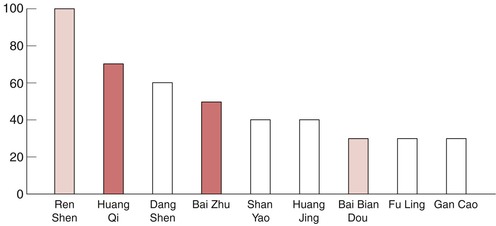 |
| Fig. 14.1. |
| Comparison of the herbs that tonify the Qi. Ren Shen ( Ginseng radix), Huang Qi ( Astragali radix), Dang Shen ( Codonopsis radix), Bai Zhu ( Atractylodis macrocephalae rhizoma), Shan Yao ( Dioscoreae rhizoma), Huang Jing ( Polygonati rhizoma), Bai Bian Dou ( Dolichoris lablab semen), Fu Ling ( Poria), Gan Cao ( Glycyrrhizae radix). |
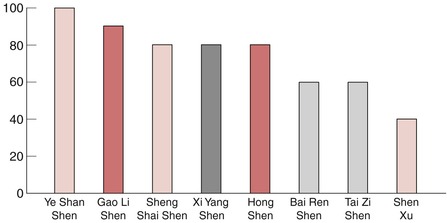 |
| Fig. 14.2. |
| Comparison of the different Ren Shen products. Ye Shan Shen (wild mountain Ginseng radix), Gao Li Shen (Korean Ginseng radix), Sheng Shai Shen (raw dried Ginseng radix), Xi Yang Shen ( Panacis quinquefolii radix), Hong Shen (red Ginseng radix), Bai Ren Shen (white Ginseng radix), Tai Zi Shen ( Pseudostellariae radix), Shen Xu ( Ginseng fibrosa). |
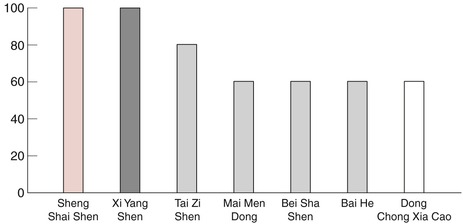 |
| Fig. 14.3. |
| Comparison of the herbs that tonify both the Qi and Yin. Sheng Shai Shen (raw dried Ginseng radix), Xi Yang Shen ( Panacis quinquefolii radix), Tai Zi Shen ( Pseudostellariae radix), Mai Men Dong ( Ophiopogonis radix), Bei Sha Shen ( Glehniae radix), Bai He ( Lilii bulbus), Dong Chong Xia Cao ( Cordyceps sinensis). |
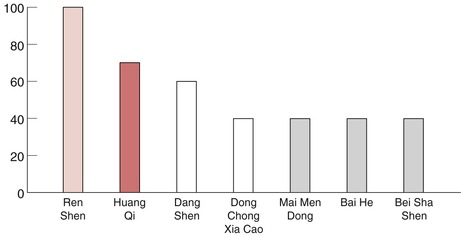 |
| Fig. 14.4. |
| Comparison of the herbs that tonify the Lung-Qi. Ren Shen ( Ginseng radix), Huang Qi ( Astragali radix), Dang Shen ( Codonopsis radix), Dong Chong Xia Cao ( Cordyceps sinensis), Mai Men Dong ( Ophiopogonis radix), Bai He ( Lilii bulbus), Bei Sha Shen ( Glehniae radix). |
 |
| Fig. 14.5. |
| Comparison of the herbs that tonify the Spleen-Qi. Ren Shen ( Ginseng radix), Huang Qi ( Astragali radix), Dang Shen ( Codonopsis radix), Bai Zhu ( Atractylodis macrocephalae rhizoma), Shan Yao ( Dioscoreae rhizoma), Fu Ling ( Poria), Gan Cao ( Glycyrrhizae radix), Yi Tang ( Maltose), Da Zao ( Jujubae fructus). |
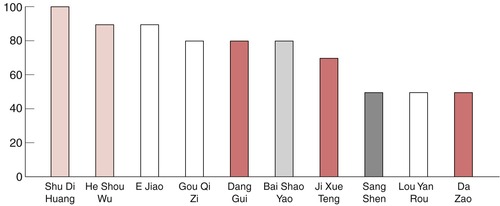 |
| Fig. 14.6. |
| Comparison of the herbs that tonify the Blood. Shu Di Huang ( Rehmanniae radix praeparata), He Shou Wu ( Polygoni multiflori radix), E Jiao ( Asini corii colla), Gou Qi Zi ( Lycii fructus), Dang Gui ( Angelicae sinensis radix), Bai Shao Yao ( Paeoniae radix lactiflora), Ji Xue Teng ( Spatholobi caulis et radix), Sang Shen ( Mori fructus), Long Yan Rou ( Longanae arillus), Da Zao ( Jujubae fructus). |
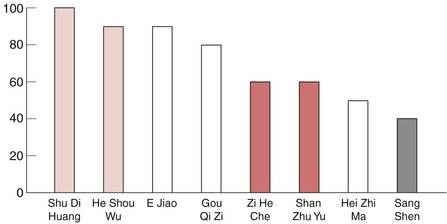 |
| Fig. 14.7. |
| Comparison of the herbs that tonify the Kidney-Essence and the Liver-Blood. Shu Di Huang ( Rehmanniae radix praeparata), He Shou Wu ( Polygoni multiflori radix), E Jiao ( Asini corii colla), Gou Qi Zi ( Lycii fructus), Zi He Che ( Placenta hominis), Shan Zhu Yu ( Corni fructus), Hei Zhi Ma ( Sesami semen nigricum), Sang Shen ( Mori fructus). |
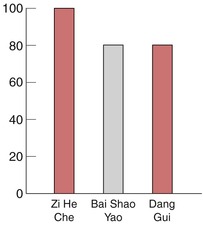 |
| Fig. 14.8. |
| Comparison of the herbs that tonify the Liver-Blood. Zi He Che ( Placenta hominis), Bai Shao Yao ( Paeoniae radix lactiflora), Dang Gui ( Angelicae sinensis radix). |
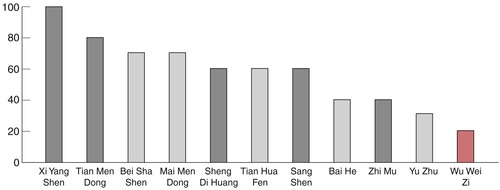 |
| Fig. 14.9. |
| Comparison of the herbs that nourish the Lung-Yin. Xi Yang Shen ( Panacis quinquefolii radix), Tian Men Dong ( Asparagi radix), Bei Sha Shen ( Glehniae radix), Mai Men Dong ( Ophiopogonis radix), Sheng Di Huang ( Rehmanniae radix), Tian Hua Fen ( Trichosanthis radix), Sang Shen ( Mori fructus), Bai He ( Lilii bulbus), Zhi Mu ( Anemarrhenae rhizoma), Yu Zhu ( Polygonati odorati rhizoma), Wu Wei Zi ( Schisandrae fructus). |
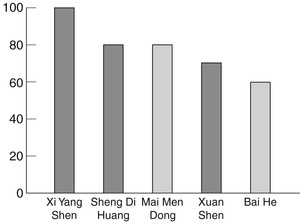 |
| Fig. 14.10. |
| Comparison of the herbs that nourish the Heart-Yin. Xi Yang Shen ( Panacis quinquefolii radix), Sheng Di Huang ( Rehmanniae radix), Mai Men Dong ( Ophiopogonis radix), Xuan Shen ( Scrophulariae radix), Bai He ( Lilii bulbus). |
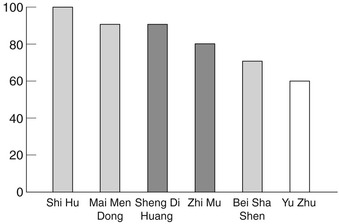 |
| Fig. 14.11. |
| Comparison of the herbs that nourish the Stomach-Yin. Shi Hu ( Dendrobii caulis)**, Mai Men Dong ( Ophiopogonis radix), Sheng Di Huang ( Rehmanniae radix), Zhi Mu ( Anemarrhenae rhizoma), Bei Sha Shen ( Glehniae radix), Yu Zhu ( Polygonati odorati rhizoma). |
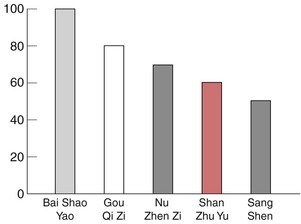 |
| Fig. 14.12. |
| Comparison of the herbs that nourish the Liver-Yin. Bai Shao Yao ( Paeoniae radix lactiflora), Gou Qi Zi ( Lycii fructus), Nu Zhen Zi ( Ligustri lucidi fructus), Shan Zhu Yu ( Corni fructus), Sang Shen ( Mori fructus). |
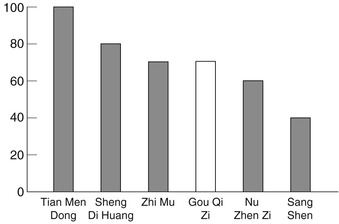 |
| Fig. 14.13. |
| Comparison of the herbs that nourish the Kidney-Yin. Tian Men Dong ( Asparagi radix), Sheng Di Huang ( Rehmanniae radix), Zhi Mu ( Anemarrhenae rhizoma), Gou Qi Zi ( Lycii fructus), Nu Zhen Zi ( Ligustri lucidi fructus), Sang Shen ( Mori fructus). |
 |
| Fig. 14.14. |
| Comparison of the herbs that tonify the Kidney-Yin and the Kidney-Essence. Shu Di Huang ( Rehmanniae radix praeparata), He Shou Wu ( Polygoni multiflori radix), Gou Qi Zi ( Lycii fructus), Tu Si Zi ( Cuscutae semen), E Jiao ( Asini corii colla), Sang Shen ( Mori fructus), Hei Zhi Ma ( Sesami semen nigricum). |
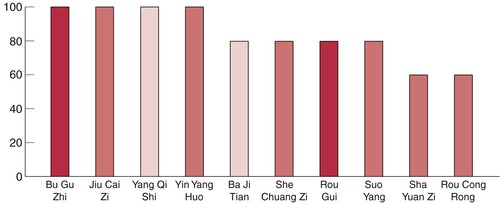 |
| Fig. 14.15. |
| Comparison of the herbs that strengthen the Kidney-Yang and tonify the Kidney-Essence. Bu Gu Zhi ( Psoraleae fructus), Jiu Cai Zi ( Allii tuberosi semen), Yang Qi Shi ( Actinolitum), Yin Yang Huo ( Epimedii herba), Ba Ji Tian ( Morindae radix), She Chuang Zi ( Cnidii fructus), Rou Gui ( Cinnamomi cassiae cortex), Suo Yang ( Cynomorii caulis), Sha Yuan Zi ( Astragali complanati semen), Rou Cong Rong ( Cistanchis herba)**. |
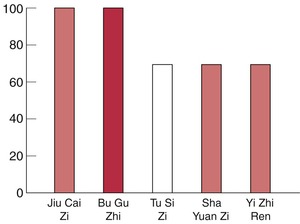 |
| Fig. 14.16. |
| Comparison of the herbs that strengthen the Kidney-Yang, tonify and stabilize the Kidney-Essence. Jiu Cai Zi ( Allii tuberosi semen), Bu Gu Zhi ( Psoraleae fructus), Tu Si Zi ( Cuscutae semen), Sha Yuan Zi ( Astragali complanati semen), Yi Zhi Ren ( Alpiniae oxyphyllae fructus). |
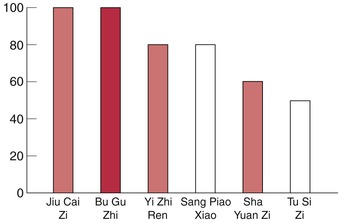 |
| Fig. 14.17. |
| Comparison of the herbs that tonify the Kidney and stabilize the function of the Bladder. Jiu Cai Zi ( Allii tuberosi semen), Bu Gu Zhi ( Psoraleae fructus), Yi Zhi Ren ( Alpiniae oxyphyllae fructus), Sang Piao Xiao ( Mantidis oötheca), Sha Yuan Zi ( Astragali complanati semen), Tu Si Zi ( Cuscutae semen). |
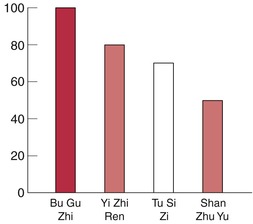 |
| Fig. 14.18. |
| Comparison of the herbs that tonify the Kidney-Yang and stop diarrhea. Bu Gu Zhi ( Psoraleae fructus), Yi Zhi Ren ( Alpiniae oxyphyllae fructus), Tu Si Zi ( Cuscutae semen), Shan Zhu Yu ( Corni fructus). |
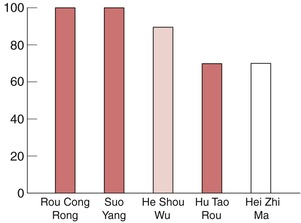 |
| Fig. 14.19. |
| Comparison of the herbs that tonify the Kidney-Yang and moisten the intestines. Rou Cong Rong ( Cistanchis herba)**, Suo Yang ( Cynomorii caulis), He Shou Wu ( Polygoni multiflori radix), Hu Tao Rou ( Juglandis semen), Hei Zhi Ma ( Sesami semen nigricum). |
 |
| Fig. 14.20. |
| Comparison of the herbs that tonify the Kidney and strengthen the bones. Du Zhong ( Eucomniae cortex), Gou Ji ( Cibotii rhizoma)**, Xu Duan ( Dipsaci radix), Gu Sui Bu ( Drynariae rhizoma), Ba Ji Tian ( Morindae radix), Yin Yang Huo ( Epimedii herba), Sang Ji Sheng ( Taxilli herba). |
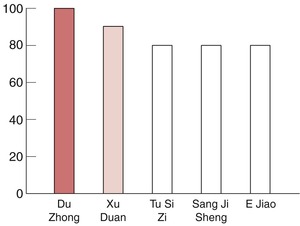 |
| Fig. 14.21. |
| Comparison of the herbs that tonify the Kidney and calm the fetus. Du Zhong ( Eucomniae cortex), Xu Duan ( Dipsaci radix), Tu Si Zi ( Cuscutae semen), Sang Ji Sheng ( Taxilli herba), E Jiao ( Asini corii colla). |
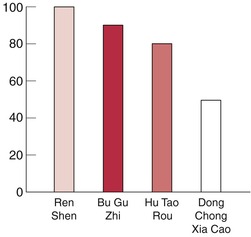 |
| Fig. 14.22. |
| Comparison of the herbs that tonify the Kidney-Qi and stabilize the Lung-Qi. Ren Shen ( Ginseng radix), Bu Gu Zhi ( Psoraleae fructus), Hu Tao Rou ( Juglandis semen), Dong Chong Xia Cao ( Cordyceps sinensis). |
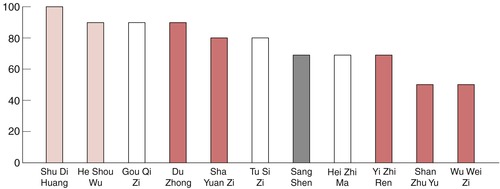 |
| Fig. 14.23. |
| Comparison of the herbs that tonify the Kidney and improve the memory. Shu Di Huang ( Rehmanniae radix praeparata), He Shou Wu ( Polygoni multiflori radix), Gou Qi Zi ( Lycii fructus), Du Zhong ( Eucomniae cortex), Sha Yuan Zi ( Astragali complanati semen), Tu Si Zi ( Cuscutae semen), Sang Shen ( Mori fructus), Hei Zhi Ma ( Sesami semen nigricum), Yi Zhi Ren ( Alpiniae oxyphyllae fructus), Shan Zhu Yu ( Corni fructus), Wu Wei Zi ( Schisandrae fructus). |
References
Li, Dong Yuan, Discussion on the Spleen and Stomach (Pi Wei Lun). First published in 1249 ( 1976)People’s Health Publishing House, Beijing.
Zhang, Zhong Jing, Discussion on the febrile diseases (Shang Han Lun). ( 1963)People’s Medical Publishing House, Beijing.

